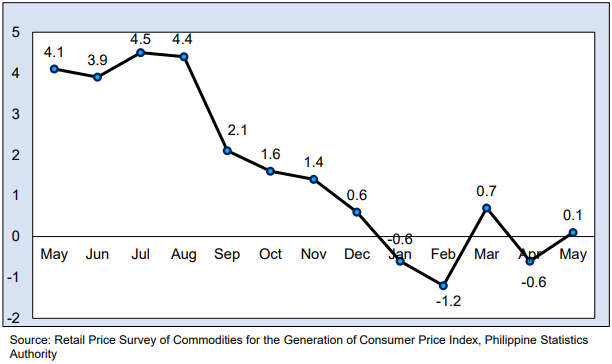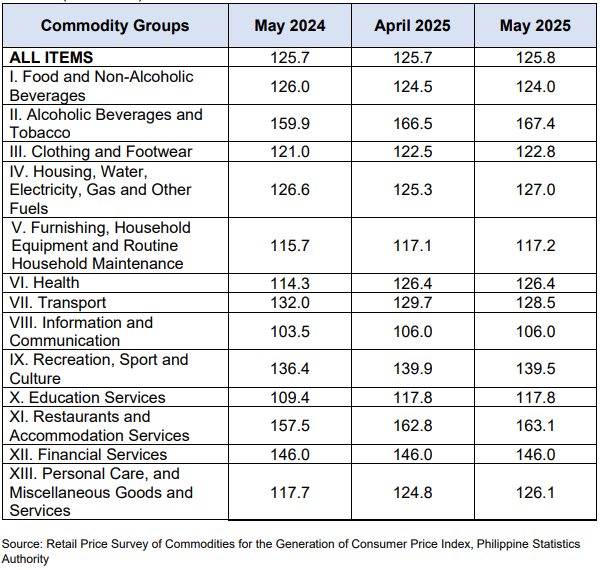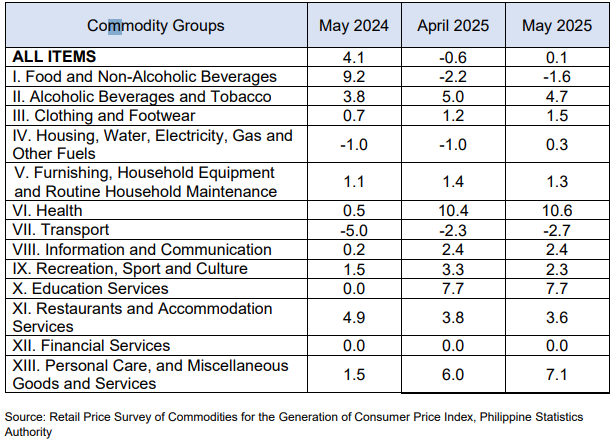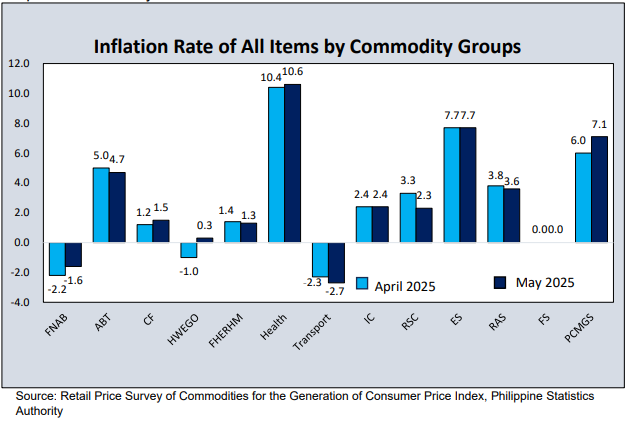Table 1. Year-on-Year Inflation Rates in Apayao Province, All Items in Percent May 2025 (2018=100)

The province’s inflation rate accelerated to 0.1 percent in May 2025 from -0.6 percent in April 2025. It is lower by 4.0 percentage points compared with the same month of the previous year at 4.1 percent and 0.7 percentage point higher than April 2025 at -0.6 percent. (Table 1 and Figure 1)
Figure 1. Year-on Year Inflation Rate, All Items in Percent, May 2024 – May 2025 (2018=100)

Table 2. Year-on-Year Consumer Price Index in Apayao, By Commodity Groups in Percent (2018=100)

The overall CPI increased from 125.7 of the same month of the previous year to 125.8 in May 2025, representing a 0.1 percent inflation rate. The data shows that the value of goods amounting to 100 pesos in the base year 2018 values 125.70 pesos in May 2024; 127.70 pesos in April 2025; and 125.80 pesos in May 2025. When the CPI increases, it indicates that the average price level of goods and services has also increased, and vice versa. (Table 2)
Table 3. Year-on-Year Inflation Rates in Apayao, By Commodity Groups in Percent (2018=100)

The commodity groups which shared in the trend during the period are:
1. Food and Non-Alcoholic Beverages, which accounted for -1.6 percent inflation and had a 51.1 percent share;
2. Housing, Water, Electricity, Gas and Other Fuels, which accounted for 0.3 percent inflation and had a 36.0 percent share;
3. Personal Care, and Miscellaneous Goods and Services, which accounted for 7.1 percent inflation and had a 9.3 percent share;
4. Clothing and Footwear, which accounted for 1.5 percent inflation and had a 2.7 percent share; and
5. Health, which accounted for 10.6 percent inflation and had a 0.9 percent share;
Moreover, the following commodity sub-class which had the highest percent share in the trend during the month of May 2025 are:
1. Electricity with 36.0 percent;
2. Dates, figs and tropical fruits, fresh with 21.6 percent;
3. Eggs chilled with 13.1 percent;
4. Other vegetables, fresh or chilled with 6.2 percent;
5. Fruit-bearing vegetables, fresh or chilled with 5.5 percent;
6. Other appliances, articles and products for personal care with 4.9 percent;
7. Leafy or stem vegetables, fresh or chilled with 3.2 percent;
8. Garments for men or boys with 2.7 percent;
9. Travel goods and articles for babies and other personal effects n.e.c. with 2.2 percent; and
10.Hairdressing and Personal grooming treatments with 1.1 percent;
Meanwhile, the commodity groups which contributed to the inflation are:
1. Personal Care and Miscellaneous Goods and Services which shared 772.0% and has an inflation rate of 7.1 percent, particularly on other appliances and products for personal care;
2. Health which shared 578.5% and has an inflation rate of 10.6 percent, particularly on Preventive care services; and
3. Alcoholic Beverages and Tobacco, which shared 278.2% and has an inflation rate of 4.7 percent, particularly on Tobacco.
However, there are commodity groups which decreased on their inflation rate compared to the previous month:
1. Alcoholic Beverages and Tobacco, which decreased by 0.3 percentage point;
2. Transport, which decreased by 0.4 percentage point;
3. Furnishings, Household Equipment and Routine Household Maintenance, which decreased by 0.1 percentage point;
4. Recreation, Sport and Culture, which decreased by 1.0 percentage point; and
5. Restaurants and Accommodation Services, which decreased by 0.2 percentage point. (Table 3 and Figure 2)
On the other hand, the commodity groups with constant inflation compared to the previous month are:
1. Information and Communication with 2.4 percent;
2. Education Services with 7.7 percent; and
3. Financial Services with 0.0 percent. (Table 3 and Figure 2)
Figure 2. Inflation Rate of All Items by Commodity Groups, Comparison Between April 2025 and May 2025

Figure 3. Purchasing Power of Peso in Apayao (2018=100): May 2018 – May 2025

Purchasing Power of Peso (PPP) recorded at 0.79 in May 2025
Purchasing power of peso continues to weaken through the years and reached 0.79 in May 2025. It decreased on the month of May compared to the previous month. The PPP of 0.79 implies that the Php1.00 in the base year 2018 values only Php 0.79 in May 2025. A low purchasing power signifies that the currency has depreciated in value and can acquire a reduced amount of goods and services. Conversely, a high purchasing power of the peso indicates that the currency can purchase a greater quantity of goods and services. (Figure 3)
DEFINITION OF TERMS
Consumer Price Index (CPI) measures the overall change in consumer prices based on a representative basket of goods and services over time.
All Income Households refers to the average Filipino income-earning households, encompassing those from high, middle, and low-income brackets, and their expenditures are reflected in the current CPI weights.
Inflation refers to an overall increase in the Consumer Price Index (CPI), which is a weighted average of prices for different goods.
Purchasing power of the peso shows how much the peso in the base period is worth in the current period. It is computed as the reciprocal of the CPI for the period under review multiplied by 100.
Commodity Groups are group of goods and services found in the market basket of the province. There are thirteen (13) commodity groups which were arranged according to the PCOICOP.
FNAB stands for Food and Non-Alcoholic Beverages
ABT stands for Alcoholic Beverages and Tobacco
CF stands for Clothing and Footwear
HWEGO stands for Housing, Water, Electricity, Gas, and Other Fuels
FHERHM stands for Furnishings, Household Equipment and Routine Household Maintenance
IC stands for Information and Communication
RSC stands for Recreation, Sport, and Culture
ES stands for Education Services
RAS stands for Restaurants and Accommodation Services
FS stands for Financial Services
PCMGS stands for Personal Care, Miscellaneous Goods and Services
Approved by:
GEOFFREY B. CALIMUHAYAN
Chief Statistical Specialist
LSBT

